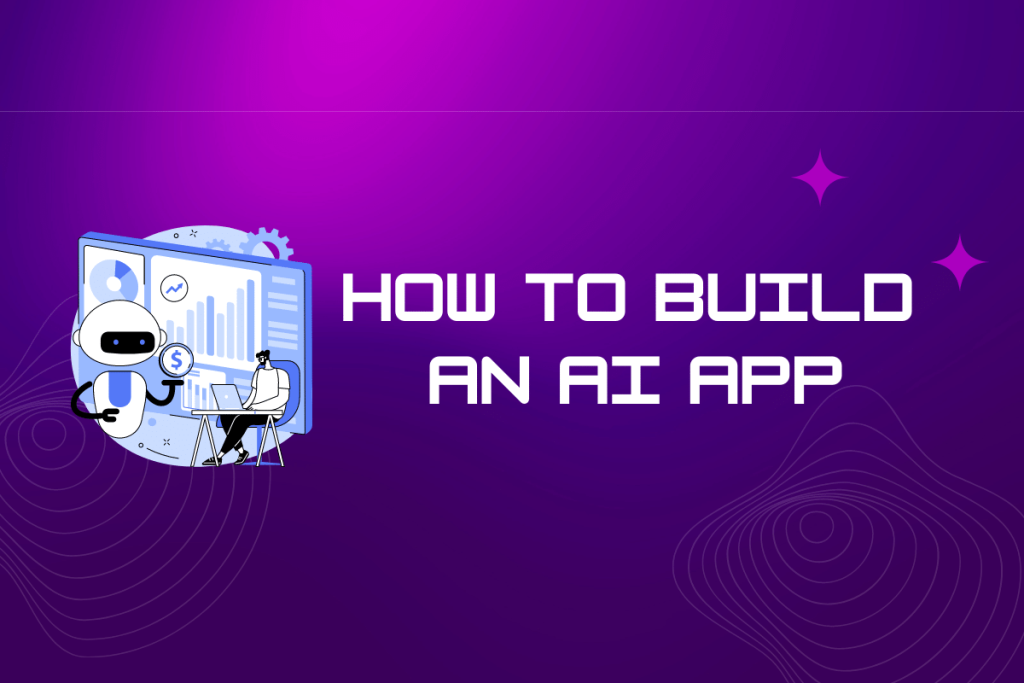Artificial Intelligence has become an integral part of the tech industry, with its applications ranging from image assistants to predictive analysis. Building an AI app might seem daunting, but following the proper steps is achievable. In this article, we’ll dive deeply into building an AI app. We’ll cover everything from understanding what an AI app is to the tools and resources you need to create one.

Table of Contents
What Is an AI?
AI stands for Artificial Intelligence, which refers to the ability of machines to perform tasks that typically require human intelligence, such as learning, problem-solving, and decision-making. AI systems use algorithms and statistical models to analyze data and make predictions or decisions based on that analysis.
AI can be used in several fields such as in DApps development to enhance functionality and provide better user experiences. For example, AI algorithms can analyze user data and provide personalized recommendations or automate specific tasks within the DApp. Additionally, AI can improve the security and efficiency of DApps by detecting and mitigating potential threats or errors in the system. Overall, the combination of AI and DApps has the potential to revolutionize the way we interact with decentralized networks and applications.
How Does AI Work?
AI works by processing large amounts of data through machine learning algorithms. These algorithms use statistical techniques to identify patterns in the data and learn from them. As the algorithm processes more data, it becomes better at predicting outcomes or making decisions based on that data.
There are several types of machine learning algorithms, including supervised learning, unsupervised learning, and reinforcement learning. Supervised learning involves providing the algorithm with labeled data, allowing it to learn to classify new data based on those labels. Unsupervised learning involves feeding the algorithm unlabelled data and allowing it to identify patterns and structures independently. Reinforcement learning involves the algorithm learning from trial and error, receiving feedback on its actions, and adjusting its behavior.
In addition to machine learning algorithms, AI systems use natural language processing (NLP), computer vision, and other technologies to understand and interact with humans in various fields, such as crypto games, IOT, and Ethereum.
Overall, AI systems work by processing large amounts of data and using algorithms to learn and improve over time, allowing them to perform tasks that would otherwise require human intelligence.
Types of AI Apps
Before we dive into the tools available for building an AI app, it’s essential to understand the different types of AI apps. AI applications can be broadly classified into three categories:
Reactive Machines
Reactive Machines are the most straightforward AI application programmed to react to specific situations based on pre-determined rules. They can’t learn from past experiences or make decisions on their own. For example, imagine a robot programmed only to move forward when it detects a specific obstacle in its path. It cannot learn to avoid other types of obstacles or change its behavior unless it is reprogrammed. Reactive Machines are useful in applications like voice assistants or game-playing AI, where they can react to specific inputs and produce pre-determined outputs.
Limited Memory
Limited memory AI apps can use past experiences to make decisions. These machines can learn from data and use that data to make decisions. However, they can’t form long-term memories.
Self-Aware AI
Self-aware AI apps are the most advanced type of AI. These machines can understand their environment and make decisions based on that understanding. They can form memories and use those memories to make decisions.
How to Build an AI App
Ready to create an innovative AI app? With the right guidance and tools, it’s doable. Here are some steps to get started.
- Define Your AI App’s Objective
The first step in building an AI app is defining its objective. What problem are you trying to solve with your AI app? What business process do you want to automate? Defining your AI app’s objective will help you determine the type of data you need to collect, the algorithms you need to use, and the user interface you need to design.
- Collect Data for Your AI App
AI apps require a significant amount of data to train machine learning models. Therefore, the second step in building an AI app is collecting data. You can collect data from various sources, such as customer surveys, social media, and website analytics. The quality of your data will directly impact the accuracy of your AI app. Therefore, ensuring that your data is accurate, relevant, and unbiased is crucial.
- Choose the Right Machine Learning Algorithm
The third step in building an AI app is choosing a suitable machine learning algorithm. There are various machine learning algorithms such as supervised, unsupervised, and reinforcement learning. Each algorithm has its strengths and weaknesses. Therefore, choosing the correct algorithm that fits your AI app’s objective is essential. The table below is a summary of machine language algorithms and their description:
Machine Learning Algorithm | Description |
| Supervised Learning | A type of machine learning where the model is trained on labeled data, meaning it’s given input and expected output. It then uses this information to make predictions on new, unseen data. |
| Unsupervised Learning | A type of machine learning where the model is given input data without any labels or guidance. The model must find patterns and structures within the data on its own. |
| Reinforcement Learning | A type of machine learning where the model learns through trial and error. It receives feedback in the form of rewards or punishments based on its actions and uses this feedback to adjust its behavior and improve over time. |
- Train Your Machine Learning Model
Once you have collected the data and chosen the right algorithm, the next step is to train your machine-learning model. Training a machine learning model involves feeding it with a large amount of data and adjusting its parameters until it can make accurate predictions. Splitting your data into training and testing sets is vital to accurately evaluate your model’s performance.
- Build Your AI App’s User Interface
The fifth step in building an AI app is designing the user interface. The user interface is the face of your AI app, and it should be user-friendly and intuitive. The user interface should allow users to interact with your AI app’s features and provide feedback to improve performance.
- Deploy and Monitor Your AI App
The final step in building an AI app is deploying and monitoring it. Once you have built your AI app, you need to deploy it to a production environment where users can access it. It is crucial to monitor your AI app’s performance continuously and collect feedback from users to improve its accuracy and functionality.
Tools for Building an AI App
There are several tools available to help on how to building an AI app, depending on the type of app you want to build and your level of expertise in AI development. Here are some popular tools:
Programming Languages
There are many programming languages you can use in ai app development, such as Python, Java, and R. Python is the most popular language for AI development due to its simplicity, flexibility, and extensive libraries. Some special computer languages can help you create AI apps. Here are some of the most famous ones:
- Python
- Java
- C++
- R
- Prolog
- Haskell
- Rust
Frameworks and Libraries
Frameworks and libraries can help you speed up the development process and make it easier to build your AI app. Popular AI frameworks include TensorFlow, PyTorch, and Keras. These frameworks provide pre-built algorithms and models, making it easier for developers to realize on how to build AI applications.
Cloud Services
Cloud services, such as Amazon Web Services (AWS) and Microsoft Azure, can provide the infrastructure you need to develop, train, and deploy your AI app. These services offer scalable computing power, storage, and other resources to help you build your application more efficiently.
Best Practices for Building an AI App
Keep It Simple
When building an AI app, it’s essential to keep it simple. Start with a small problem and dataset, and gradually increase the complexity as you gain experience.
Stay Organized
Organizing your code, data, and experiments is essential to building a successful AI app. Use version control software like Git to track changes and document your progress.
Ensure Data Privacy
Privacy is a significant concern when working with personal data. Ensure you follow data privacy regulations and ethical guidelines when building your AI app.
Use Good Quality Data
Using good-quality data is crucial for building an effective AI app. Poor quality data can lead to inaccurate results, which can have significant consequences. Ensuring that your data is clean, accurate, and up-to-date is essential.
Choose the Right Model
Choosing the suitable model for your problem is critical to success. Consider the type of problem you’re trying to solve and the complexity of your data when choosing your model.
Test Your App
Testing your AI app is critical to ensure that it’s working correctly. Testing can help identify any bugs or errors in the algorithm and data. Testing your app in different market conditions is essential to ensure it’s robust and effective.
Use Ethical Considerations
AI can significantly impact society, and it’s important to consider ethical implications when building an AI app. Ensure that your app is designed to be fair, transparent, and unbiased.
Challenges in Building an AI App
Building an AI app can be a complex and challenging task. There are several challenges that you may encounter during the development process. Understanding these challenges can help you prepare and overcome them.
Data Quality and Quantity
The quality and quantity of data are crucial factors in building an AI app. The accuracy of your model depends on the quality of data you feed it. Insufficient or poor-quality data can result in inaccurate predictions and unreliable results. You need to ensure that your data is clean, relevant, and sufficient to train your model effectively.
Algorithm Selection and Optimization
Choosing the right algorithm is another challenge in building an AI app. There are several algorithms available, and selecting the most appropriate one for your app can be a daunting task. You also need to optimize your algorithm to ensure it performs efficiently and accurately.
Model Interpretability and Explainability
Interpretability and explainability of your model are essential factors. You need to ensure that your model’s output is interpretable and explainable to users. This will help build trust and confidence in your app and its predictions.
Security and Privacy
Security and privacy are significant concerns when building an AI app. You need to ensure that your app is secure and user data is protected. You also need to comply with privacy regulations and ensure that user data is not misused or mishandled.
Conclusion
Building an AI app requires a combination of technical expertise, creativity, and a deep understanding of the problem you are trying to solve. It is crucial to start with a clear vision of what you want to achieve and then work with a team of experts to design and develop the app. This involves selecting suitable algorithms, data sources, and tools and testing and refining the app to ensure it delivers the desired outcomes. With the right approach, building an AI app can be a rewarding and impactful experience, enabling you to create innovative solutions that transform how we live and work.

An experienced leader in software engineering and technology, I’ve driven value for top-tier Fortune 100 and 500 clients as the former CTO of Big Drop Inc. Overseeing a global team, we secured 34 global awards for pioneering web design using our proprietary tech. As the Co-Founder of Motion Design School, I created an innovative platform for global artists. Now, I apply my expertise to the dynamic world of blockchain, leveraging years of experience to shape decentralized technology’s future.